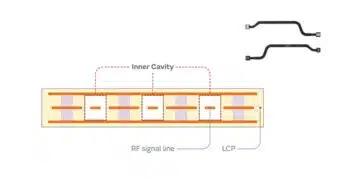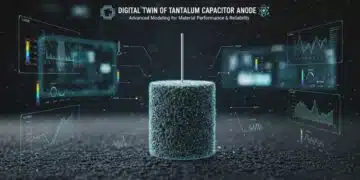The paper “Advances in the Environmental Performance of Polymer Capacitors” was presented by Philip Lessner Consultant, South Carolina, USA at the 5th PCNS Passive Components Networking Symposium 9-12th September 2025, Seville, Spain as Keynote paper III.
Introduction
This article provides a comprehensive examination of the advances in the environmental performance of polymer capacitors, particularly aluminum capacitors and tantalum capacitors with conductive polymer cathodes.
Since their introduction in the mid-1990s for consumer electronics, these capacitors have evolved to meet the stringent requirements of automotive, defense/aerospace, and high-performance data center applications.
The paper delves into the degradation mechanisms under stress conditions involving temperature, voltage, and humidity, and highlights material science innovations that have enabled higher reliability and longer lifetimes.
Key Points
- Evolution of Polymer Capacitors: Early capacitors were limited to 85–105°C and moderate humidity, but modern designs meet AEC-Q200 and MIL-SPEC requirements.
- Dielectric Reliability: Tantalum pentoxide formation, oxygen migration, and crystallization are key factors affecting lifetime.
- Conductive Polymer Degradation: ESR increase and capacitance loss due to thermal and humidity effects are now better understood.
- Environmental Performance: Humidity and high-temperature exposure mechanisms have been identified, leading to improved packaging materials and cathode polymers.
- Applications: Automotive, defense/aerospace, and AI data centers demand long-term reliability, up to 100,000 hours or more.
Extended Summary
The development of polymer capacitors began with applications in portable electronics, where moderate temperature and humidity tolerance was sufficient. Initial tantalum and aluminum conductive polymer capacitors reduced Equivalent Series Resistance (ESR), a critical factor as digital circuits advanced. Their limited voltage and thermal performance restricted them to low-voltage consumer devices.
Breakthroughs in polymer chemistry and capacitor design around 2008 enabled higher voltage ratings (up to 75V) and improved thermal and humidity performance. This opened opportunities in automotive electronics, where AEC-Q200 standards require 125°C operation and 85°C/85%RH humidity tolerance. Subsequent adoption in defense and aerospace led to the development of COTS and MIL-SPEC series, and hermetically sealed units for harsh environments.
Dielectric reliability is primarily governed by the quality of the tantalum pentoxide layer. Oxygen migration induces conductive pathways, while crystallization of the dielectric under high voltage and temperature can lead to breakdown. Self-healing mechanisms in conductive polymer cathodes provide some resilience, but oxidation and thermal degradation can limit life, especially in air. Pre-polymerized PEDOT:PSSA provided a key improvement in high-voltage performance, while antioxidants and optimized encapsulation further enhance stability.
Humidity introduces additional failure modes, such as silver ion migration and copper dendrite formation, which cause leakage current increases and eventual shorts. Polymer delamination and ESR rise are also critical concerns. Improved epoxies, lead frame materials, and interlayer adhesion have significantly mitigated these issues, allowing modern tantalum-polymer capacitors to meet automotive and aerospace reliability standards.
In high-reliability environments like AI data centers, the focus is on sustaining 5+ year operation under continuous high-temperature conditions. Accelerated life testing and physics-based models (e.g., McPherson’s field-modified activation energy model) predict dielectric lifetimes in the hundreds to thousands of years at 85°C and nominal voltage, but ESR and capacitance degradation become the limiting factors.
Conclusion
Polymer capacitors have matured into high-reliability components suitable for demanding automotive, defense, aerospace, and data center applications. Advances in dielectric formation, polymer chemistry, and packaging have enabled significant improvements in temperature and humidity performance. While dielectric wear-out is now largely a long-term concern, thermal and humidity-induced ESR rise and capacitance loss remain active areas for further research. Continued developments in material science, encapsulation, and predictive modeling will be key to extending lifetime performance toward the 100,000-hour expectation for next-generation applications.
































